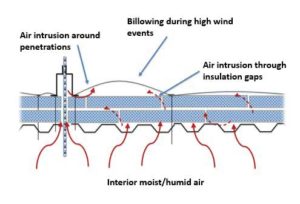Using roofing parapets for airtight roofs

Wind
Wind is created by solar heating one area of the earth, as opposed to another in which the warmed (higher pressure) air moves up into the atmosphere drawing with it and across the surface of the earth cooler (lower pressure) air. These cells are globally distributed and are responsible for much of the prevailing winds. Storms with intense winds are a similar micro-version of this alongside other factors, but temperature differences are a key driver in wind development. When a building sits in the wind’s path, the wind will try to go right through the building. It becomes a battle of strength at this point, as the wind will pass through the weak points in the building envelope or be redirected around the building to create new loads and wind speeds.
Stack
The stack effect is also due to differential air temperature but across the building envelope. When the air within a building is warmer and more buoyant than the air outside of the building, the more buoyant air will want to rise to the top of the building, much like oil in vinegar. This buoyancy example will exert outward pressure on the building envelope at higher elevations and negative pressure at lower elevations. There will be a zone halfway between these two points where the pressure will be neutral, this is called the “neutral zone.” The stack effect will increase based on the height of a building and can become almost unmanageable and capable of intense physical damage.
Mechanical effect
Mechanical effect is imposed on the envelope by the mechanical air handling systems of a building. In order to properly balance the air handling system and ensure proper flow per design requirements, these mechanical systems take in more air than they exhaust. By doing this, they slightly increase the pressure within the building envelope and try to account for any air leakage that may affect the mechanical systems operation (Figure 2).
Understanding leakage rates
The air leakage rate in buildings refers to the volume of air leaking either from a whole building or across a measured section of the building envelope. As a whole building measure, it can be expressed in air changes per hour (ACH) and it can often be further defined as ACH50 or ACH75, with the numerical referring to the prescribed air pressure difference across the envelope in pascals. So a building that leaks all the air volume in the timeframe of one hour at a pressure difference of 0.05 kPa (50 Pa) would be labelled as 1ACH50, and the same building that leaked twice its total volume of air in one hour would be labelled 2ACH50 and so on. Generally, buildings with lower air leakage rates of 1 to 2 ACH will perform much better than higher volumes from a comfort, energy efficiency, and durability standpoint.
Air leakage can also be measured across a section of the envelope. This measurement is expressed as L/s/m2 (cfm/sf) at 0.75 kPa (75 Pa). This is useful in comparing wall types or walls to roofs. One would expect a commercial multi-unit residential wall riddled with windows and vents and pipes to have a higher leakage rate per square meter (m2) than a commercial flat roof assembly—this is good information to have when attempting to reduce overall building air leakage.
So how does the current inventory of buildings stack up? On average, Ontario detached homes have a 7.5 ACH, as per the Canada Mortgage and Housing Corporation (CMHC) 2017 study;1 and average commercial buildings in U.S. have 13.1 ACH, as per the National Institute of Standards and Technology (NIST) 2014 study.2
Air and the roof
How does wind and air movement affect a roof? This is a simple question with a very complex answer, which is prefaced by, it depends on how much time there is to explain it? Simply put, as wind rushes around and over the surface of a low-slope roof, it creates wind uplift because of a phenomena called the “Bernoulli effect.” This is the same physics that allows airplane wings to create lift. The National Research Council of Canada (NRC) has developed an online tool to assist designers in determining how this applies to their specific intended building design.
“As part of the Wind-RCI family of online tools for the roofing community, this calculator determines the resistance of the tested low-slope membrane roofing specimens in accordance with the CSA Group’s standard CSA A123.21, Standard test method for the dynamic wind uplift resistance of membrane-roofing systems.”3


